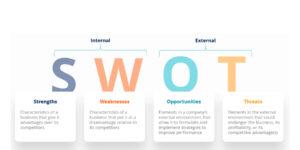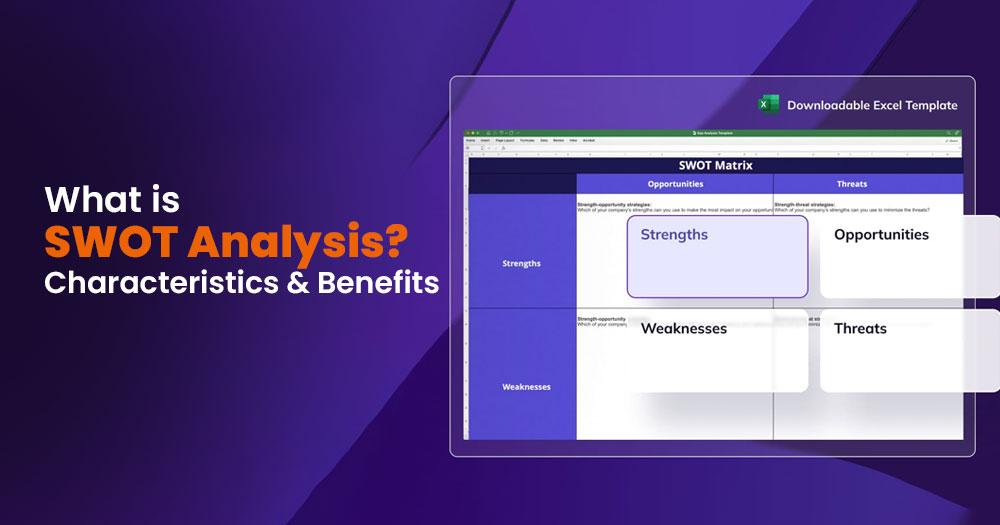Businesses must periodically assess their performance and maintain things recently. This guarantees efficiency and aids in the early detection of issues. You may achieve this by using a technique called SWOT analysis.
Checking your company’s Strengths, Weaknesses, Opportunities, and Threats (SWOT) is a planning process that aids in overcoming problems and identifying potential new business prospects.
What is SWOT analysis?
The four pillars of a SWOT analysis are strengths, weaknesses, opportunities, and threats for the business. m may use it for various initiatives within a single department, business, or organization.
SWOT analysis can be used to assess how well a particular project, like an online advertising campaign, is performing compared to initial projections. They are most often used at the organizational level to assess how closely a business is aligned with its growth criteria and success benchmarks.
A SWOT analysis’s primary goal is to help enterprises fully understand all the variables that go into choosing a course of action. During the research, for determining the reason why business planning repeatedly fails, Albert Humphrey of the Stanford Research Institute develop the strategy in the 1960s. Since its inception, SWOT analysis has emerged as one of the most effective tools for company owners for launching and expanding their enterprises.
You may also like to read: What is business analysis?
What are the characteristics of a SWOT analysis?

While writing a SWOT analysis, people often make a table with four columns, listing each prospect that will have an influence side by side for contrast. Although they should relate because opportunities and threats are ultimately connected, strengths and weaknesses rarely match the opportunities and threats listed precisely. Here are some features of SWOT analysis.
Internal Factors:
- Strength:
Strengths involve a strong brand, a dedicated client base, a solid balance sheet, innovative technology, etc., demonstrating what a firm excels at and what sets it apart from its competitors. For instance, a hedge fund could have made a proprietary trading process that outperforms the market. The next step is determining how to exploit the outcome to attract additional investors.
- Weakness:
Weaknesses are areas or traits where a company is less competitively beneficial than its competitors. A lousy brand, higher-than-average turnover, high levels of debt, an insufficient supply chain, or a lack of cash are areas where the company has to improve to remain competitive. These may be more qualitative or quantitative, just like strengths. Examples involve:
- Inept management.
- Significant staff turnover.
- Poor (or deteriorating) margins.
- A vast (or excessive) reliance on debt as a source of revenue.
The SWOT analysis’s strengths and weaknesses division may learn a lot from what goes on within the firm.
Here are examples of often thought-of internal factors:
- Financial capability (funding, sources of income, and investment opportunities)
- Physical assets (location and equipment)
- Human resources (employees and target audiences)
- Accessibility to copyrights, patents, trademarks, and natural resources
- Recent procedures (including departmental hierarchies, staff programs, and software systems like accounting software)
External Factors:
Each business, organization, and person is influenced and affected by external criteria. It is essential to observe and record each of these features, regardless of whether they are connected to an opportunity (O) or a threat (T) directly or indirectly.
- Opportunities:
The “Opportunities” section requires attention to outside elements that may help a firm expand or develop. A rising total addressable market (TAM), technology developments that may lead to maximizing efficiency, or modifications in societal norms generated by new markets or new sub-segments of recent markets are examples of opportunities to take into account.
- Threats:
Threats are elements which pose threats to an organization’s operations. Though oriented differently, the categories frequently resemble those in the “Opportunities” section. Examples involve a declining industry (the same as a declining TAM), technical advancements that might disrupt an existing company’s operations, or changed societal standards that create current product offers less appealing to a maximizing proportion of customers.
For a business to succeed, m must consider both external and internal elements. External influences are typically things neither you nor your business can control.
Examples include the following:
- Commercial trends (new products, technology advancements, and shifts in audience requirements)
- financial patterns (local, national and international financial trends)
- Funding (donations, legislature, and other sources)
- Demographics
- Relations with partners and suppliers
- Laws in politics, the circumstances, and the economy
To start a list of external causes, you can consider asking:
- What trends are seen in the market? (Opportunity)
- What racial or ethnic groups are we not including? (Opportunity)
- How much competition is there, and what is the market share? (Thread)
- Exist any current rules that could reversely affect our business or the products? (Thread)
How to conduct a SWOT Analysis?
In most cases, a SWOT analysis is part of an extensive company study and is seldom carried out independently. A helpful technique to help summarize additional results is a SWOT analysis, which is also an evaluation framework in and of itself.
For example, an analyst needs to comprehend the firm and its industry to appraise the strengths and weaknesses of a company effectively. To do this, they may want to make use of additional frameworks and tools, such as:
- Hax’s Delta Model will aid in the comprehension of rival posture.
- Ansoff’s Matrix will make it simpler to see how risky a management team’s growth plans are related to each other.
- Financial ratio analysis will show trends (year-over-year) and a firm’s performance contrary to other companies (using benchmarking data).
For external elements involving opportunities and risks, the same holds. It’s practically tough to interpret them without first taking into account the following:
- Does the company operate in a sector that is in decline or growth? Threats and opportunities are themselves being informed by this.
- The examination of the industry or the general business climate Considers models.
What are the Benefits of SWOT Analysis?
You could wonder if SWOT analysis applies to or is even doable for small businesses and organizations if you’re a marketer or small business owner. Even for the smallest of firms, doing a SWOT analysis has various advantages, even if there is undoubtedly a resource overhead involved. Here are some advantages of SWOT analysis:
- Aerial perspective: One advantage of completing a thorough SWOT analysis is the extraordinary chance it offers to learn more about how your company does its functions. Conducting a SWOT analysis allows you to obtain a broader bird’s-eye view of your firm and its position in the industry. It’s too simple to become lost in the weeds of the day-to-day operations of your organization.
- Enhancing specific initiatives and marketing: Another advantage of SWOT assessments is that they may use them in various situations and give an overview of the company. m may use SWOT assessments to assess the strengths and weaknesses of planned content production, an upcoming advertisement campaign, or whether your organization should be present at a trade show or any other industry event.
- Making concrete road maps: Naturally, the performance of SWOT analysis allows you to pinpoint the company’s strengths, areas for growth, and the possibilities and dangers it faces. However, doing a SWOT analysis allows you to identify these issues and make and implement concrete timetables and roadmaps for viable remedies. Developing financial plans, determining recruiting needs, and other mid- to long-term strategic planning can all benefit from this.
You may like to read: How Data Science is Useful for Businesses
What are the SWOT analysis mistakes?
Here are some mistakes that people can make while performing a SWOT analysis:
- You are making huge lists. As you continue, ask yourself if your ideas are practical.
- Being ambiguous with your lists. Be in detail to provide the insights conversations more direction.
- Need to recognize issues. Make sure to inquire about the experiences of clients and workers.
- Not anticipating what will happen in the future. Having a good concept is easy without following it through to its logical conclusion. Always take into account how w will use them.
- Being irrational. Only make elaborate plans for prospects that exist. For example, the export market you’ve been targeting could become available eventually, but the trade talks about making it possible may take years.
- Reliant just on a SWOT analysis. There is no doubt that SWOT analysis is advantageous, but the outcomes will be more substantial if you mix it with other planning tools (like SOAR, TOWS, or PEST).


